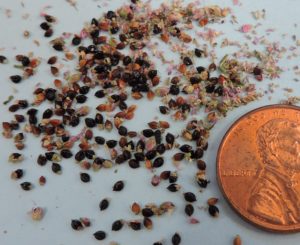Name: Oriental Lady’s-thumb
Botanical Name: Polygonum cespitosum
Form: wildflower
Parts Used: mostly seeds, some greens
Citation: Guenther, K. (2017, January 12) Oriental Lady’s-thumb as wildlife food [Web log post.] Retrieved: readers supply the date, from http://wildfoods4wildlife.com
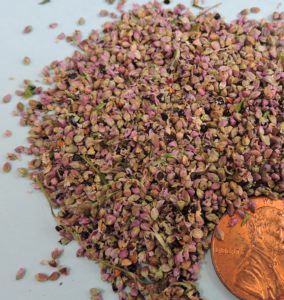
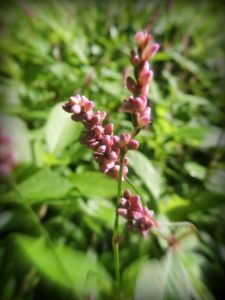
Getting Started
This genus of plants provide the #1 seed loved by wildlife on the Super Seeds List and upwards of 65 different bird and mammal species eat smartweed seed. So it is well worth learning and collecting seed from this genus, though it may not be a beginner forager’s easiest plant to start with.
However, there are at least three plants in this genus, Japanese Knotweed (Polygonum cuspidatum), Giant Knotweed (Polygonaum sachalinense) and Bohemian Knotweed (Polygonum bohemicum) which should never be collected because they are extremely difficult to eradicate, eco-system damaging, non-native plants. Fortunately, their blooms looks much different than what is pictured above. And others of the non-native polygonum species can be quite aggressive and push out native species, so care should always be taken to manage the dung from cage clean outs to not spread the seed further into the wild. If you choose to collect it at all.
When you find smartweed, you often find them in stands, not as a solitary flower. Though small, en mass they are quite beautiful!
The family Polygonaceae has recently undergone a lot of re-classifications taxonomically. It is possible to find smartweeds and knotweeds in both Persicaria and Polygonum genera. For that reason in the database I lump those two together interchangeably under Polygonum.
Polygonaceae (Buckwheat or Smartweed Family)
Persicaria (Smartweed Genus)
AND
Polygonum (Knotweed Genus)
There are a lot of plants in these two genera, so for this monograph I only listed the Virginia Persicaria species. Many of these species have the same general “look” of the pink to white wand-like flower clusters you will come to recognize. It can be difficult to identify smartweeds down to the species level.
One generally recognizable plant feature of smartweeds and knotweeds are the swollen joints (nodes) where the leaf meets the stem. Identifying to the species level often involves examination of the style of papery sheath at the joint (node) of leaf and stem.
Other Persicaria species exist in Virginia, but the flowers look a little different. These, too, can be used as birdseed, if you know them and have access to these other plants. Cardinals, sparrows, towhees, red-winged blackbirds, bobwhites and redpolls are especially fond of this seed.
| Common name | Some of the Persicaria species in Virginia | Origin | Rare Plant Status |
| Oriental lady’s-thumb | P. longiseta | non-native | not rare |
| water smartweed | P. amphibia | native | not rare |
| halberd-leaf tearthumb | P. arifolia | native | rare in some states (not Virginia) |
| east asian smartweed | P. extremiorientalis | non-native | not rare |
| dense-flowered smartweed | P. glabra | native | rare in some states (not Virginia) |
| marsh-pepper smartweed | P. hydropiper | non-native | not rare |
| mild water-pepper | P. hydropiperoides | native | rare in some states (not Virginia) |
| pale smartweed | P. lapathifolia | native | not rare |
| lady’s-thumb | P. maculosa | non-native | not rare |
| kiss-me-over-the-garden-gate | P. orientalis | non-native | not rare |
| Pennsylvania smartweed | P. pensylvanica | native | not rare |
| mile-a-minute weed | P. perfoliata | non-native | not rare |
| dotted smartweed | P. punctata | native | not rare |
| stout smartweed | P. robustior | native | Possibly threatened, only found in Prince George and Surry counties. |
| arrow-leaf tearthumb | P. sagittata | native | not rare |
| swamp smartweed | P. setaceae | native | rare in some states (not Virginia) |
| jumpseed | P. virginiana | native | not rare |

Key Features to Look For
In addition to using the identification guide of your choice, here are a couple of features you should see on this plant:
- bright pink to pale pink/white flowerheads in small, tight vertical clusters that sometimes droop over slightly
- swollen joints (nodes) where the leaf meets the stem
- leaves are three times as long as wide and gently taper to a rounded point
- pink paper chaff wraps the tiny seeds
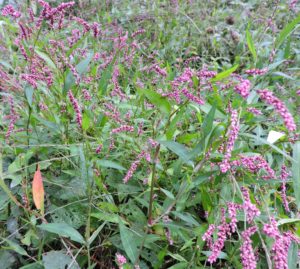
Risks
Japanese knotweed (Polygonum cuspidatum), Black bindweed (Polygonum convolvulus), Prostrate knotweed (Polygonum aviculare) have all cause livestock deaths as a green forage, possibly unrelated to nitrate poisoning.
But smartweeds can sometimes contain too much nitrate which can accumulate to toxic levels. All plants need nitrogen to grow. But for plants that are more susceptible accumulating nitrates, drought, reduced sunlight, excessive soil nitrogen from excess fertilization can over-accumulate nitrates because the plant is not growing and utilizing the nitrogen it has absorbed.
Polygonum and Persicaria spp. greens can also cause photosensitization (Burrows, G.E. & Tyrl, R.J., 2013)
Some people develop a skin sensitivity from contact with smartweed leaf—so beware if you are wading into a stand of smartweed in shorts for the first time until you know if you are sensitive. (Douglas, 2004)
Seeds have no risks indicated.
About This Species
The species of smartweed you collect may determine whether or not it is worth your effort. The first time I collected, I collected the pale smartweed which had relatively large flower clusters. For this writing, I collected bristly ladies-thumb which had smaller clusters and was more work for less result. As mentioned above, any particular smartweed species could easily be combined with other smartweed species into a birdseed mix. As always, the native species are preferable, if you can figure that identification out.
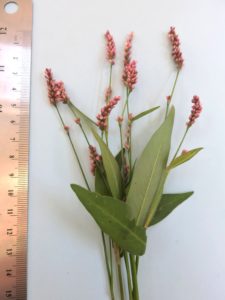
Flower Description: Flowers are bright pink to pale pink/white depending on species, in small, tight clusters. If you have the patience and micro-dexterity to deconstruct a tiny flower, you would find five petal-like pink sepals around the superior ovary.
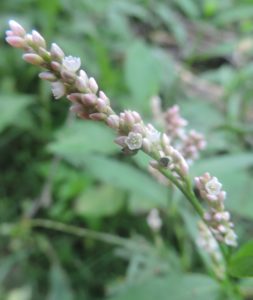
Leaf Description: Leaves are a dark green, entire. Underside is shiny and topside has fine, shiny hairs you can see if you look closely on a sunny day. Leaves are three times as long as wide and gently taper to a rounded point.
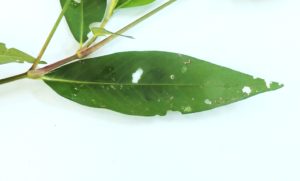
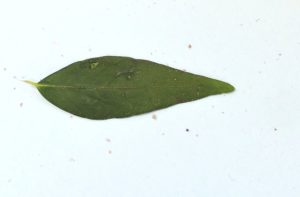
Seed/ Fruit Size: If you rub off the pink papery seed cover, you discover the very small, black and shiny seed, 5/64 inch (2 mm) long. If viewed through a hand lens, you may see the surface of the seed has three gently rounded ridges running lengthwise.
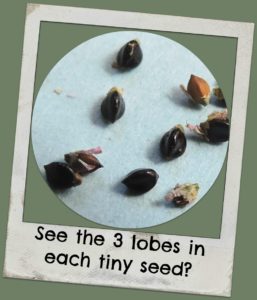
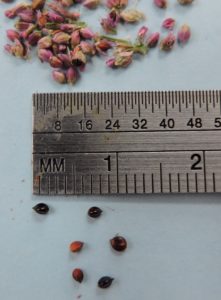
Harvest
| Jan | Feb | Mar | Apr | May | Jun | Jul | Aug | Sep | Oct | Nov | Dec | ||||||||||||||
|---|---|---|---|---|---|---|---|---|---|---|---|---|---|---|---|---|---|---|---|---|---|---|---|---|---|
| winter | winter | late winter | early spring | spring | late spring | early summer | summer | late summer | early fall | fall | late fall | ||||||||||||||
| seed | x | x | x | x | x | ||||||||||||||||||||
| greens | x | x | x | x | x | x | x | x | x | x | x | x | |||||||||||||
Does this lend itself as an enrichment item? Maybe, unless you are concerned about introducing it as a weed species onto the rehab property. The seeds of smartweed do adhere to the stem fairly well. Try creating a bundle of flower stems, tie and hang upside down to dry for 1-2 weeks indoors. Then either hang the bundles in the bird enclosures, or set bundles up in durable dry vases for the birds to forage the seed off the stem.
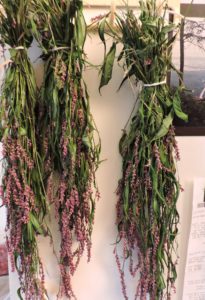
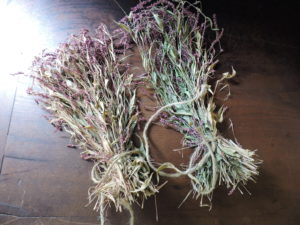
Harvesting Seed
It can be tempting to harvest smartweed too early. The plant is long-flowering and an early flower and a mature flower look almost the same.
You can test a sample. Look closely at it and see if you still see the tiny flower with petals. If so, too early. If no flower you can see, then firmly rub a few of the pink flowers until you rub off the pink papery bits of chaff off –mature seeds are dark and shiny. No seeds? Too early. Green or tan seeds? Too early. Black shiny seeds? Time to harvest and cure.
When I find a stand of mature smartweed in bloom, I grab handfuls of the upper portion of the stem and cut the flower cluster stems with scissors and toss it in a bucket, trying to avoid the leaves as much as possible. Depending on the species and how large the flower head is, it can be easy or harder to collect a lot of seed.
Spread the collected plant tops out on a sheet or drying screen for a week to dry. Stem by stem remove any dried leaves. Once you are just down to stem and flowers, rub handfuls of the material to dislodge the seeds from the flower seed head. The seed is inside the pink papery covering (chaff), so if you vigorously rub the dry pink seed in your hands, the pink outer covering will come off revealing the dark seed. If the seeds are green or tan, or the pink material does not rub off, you collected immature seeds.
I do not think there is any particular reason to try to remove the pink chaff except to check that the seed inside is, in fact, mature.
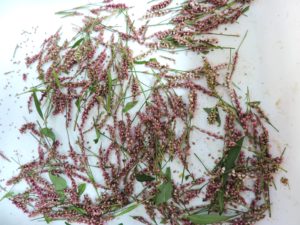
How to Store Prepared Seed
Once cleaned and fully dried, choose a low humidity day—not a rainy day—to jar up your seed.
Glass or metal works best, because all plastics are somewhat porous to humidity. Canning jars and lids work well. Place seed in a tightly sealed, glass container and store in a dark, cool area for up to 1 year. Refrigeration and freezing work well. Label the airtight container with the seed name, date of harvest and which animals it should be used for.
If you intend to keep the seed longer than one year, jar up the seeds in two stages. First, jar the seeds up using a desiccant for up to 1 week. Then check the seed for dryness, and if dry enough, remove the desiccant and immediately repack the seed into an airtight container. Read more about drying seeds and using desiccants.
Keep stored seed in an airtight glass or metal container in a cool, dark place. Refrigeration and freezing works well, but allow container to warm to room temperature before opening. Discard any seed that ever appears moldy.
Harvesting Greens
Since smartweed sometimes grows in thick, weedy stands, it is easy to harvest a lot of greens quickly. Plants are usually calf to mid-thigh tall. Just grab a cluster of stems and cut with shears. Stems and leaves can be offered to animals, though the greens taste somewhat spicy more like mustard, so animals may not eat greens in great quantity.
How to Store Greens:
If you choose to, use a commercial vegetable cleaner or a ¼ cup (60 ml) of vinegar added to wash water as a cleaner. Submerge the plant material and swish it around to remove all dirt from leaves and roots. Rinse in clean water. Always wash greens; you never know what might be on them…like animal feces or urine. Place in a colander or salad spinner to drain, then layout a towel and spread the greens on the towel and roll up the towel. Unroll and transfer the damp greens to storage.
For storage, there are a couple of different possible container methods. If the greens will be used quickly within days, place the spun-and-towel-rolled damp greens to a 1 gallon zip-lock baggie with 12-15 holes cut in it to provide air and keep the greens from molding (or reuse commercial grape bags with holes). Label the bag with the plant name and which animals it should be used for. Keep container in the vegetable drawer of the refrigerator.
For storage longer than one week, use a rigid, lidded, airtight container. After washing and salad spinning the greens, place a paper towel in the bottom, then loosely fill with greens, but do not pack them in. Then lay a paper towel on top and put on lid. Keep container in the vegetable drawer of the refrigerator. Do not use if greens become moldy, slimy or dried out.
Many greens are very sensitive to exposure to ethylene gas, though greens themselves are low emitters of the gas. You may get longer quality by adding with a product that reduces free ethylene gas in the refrigerator. Greens are good until they become dry and crispy, fade in color, or become slimy or moldy.
Read more about storing leafy greens.
Other Related Species
I’ve also included pictures of the native Jumpseed (Persicaria virginiana) here because it is so easily recognizable, but it does not have the same pink flower clusters like all the others listed above. If you have access to it, you can include these seeds in with your smartweed seed mix. They bloom at the same time as other smartweed flowers, around August where I live, and are ready for harvest in September. When the about 60-80% of the white flowers on the stalk turn brown, it is time to harvest. Grasp the stem in your hand and strip off the seed. The seeds will feel dry and will “jump” off the step, hence the name. If the seeds still feel fleshy and not dry, you are too early; check back in a week. Work over a bucket or sheet to catch the jumpers.
Let the seeds air dry inside one week. Just to prove to yourself that the seed is mature, you can roll the seeds in your fingers to break off the plant chaff, revealing the dark, shiny seed within. A mature seed is very dark. Winnowing is probably not necessary. Pictures below.
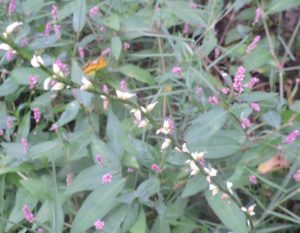
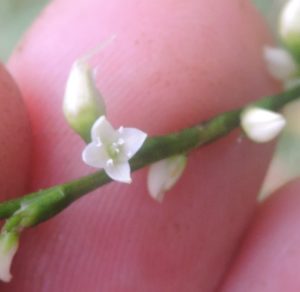
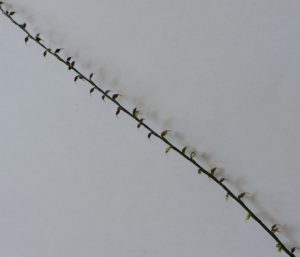
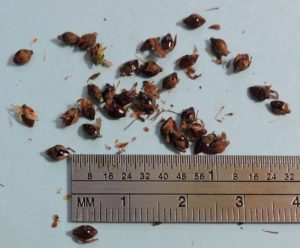
And remember, always avoid the three plants in this genus, Japanese Knotweed (Polygonum cuspidatum), Giant Knotweed (Polygonaum sachalinense) and Bohemian Knotweed (Polygonum bohemicum) which should never be collected because they are extremely difficult to eradicate, eco-system damaging, non-native plants.
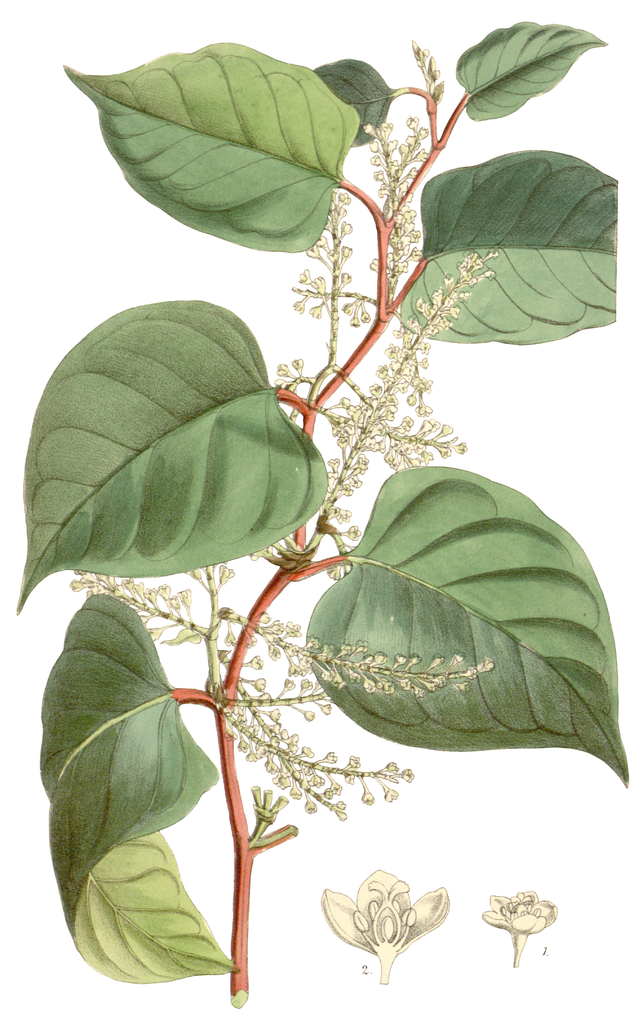
Feed smartweed to:
knotweed (smartweed) | (Polygonum spp.) | greens |
|---|---|---|
 Caution: P. cuspidatum, P. convolvulus, P. aviculare have all cause animal deaths as forage. Polygonum spp. greens can accumulate nitrates and can cause photosensitization. Leaves can cause contact dermatitis in humans. (Burrows, G.E. & Tyrl, R.J., 2013; Stoltenow & Lardy 2015; Douglas, 2004) | ||
Cottontail, Eastern | Sylvilagus floridanus |
|
Deer, White-tailed | Odocoileus virginianus |
|
Squirrel, Eastern Fox | Sciurus niger |
|
knotweed (smartweed) | (Polygonum spp.) | seeds |
 Caution: Polygonum spp. leaves can cause contact dermatitis in humans.(Douglas, 2004) | ||
Deer, White-tailed | Odocoileus virginianus |
|
Mouse, Common White-footed | Peromyscus leucopus |
|
Muskrat, Common | Ondatra zibethicus |
|
Squirrel, Eastern Fox | Sciurus niger |
|
Blackbird, Red-winged | Agelaius phoeniceus | strong preference |
Cardinal, Northern | Cardinalis cardinalis | strong preference |
Redpoll, Common | Carduelis flammea | strong preference |
Sparrow, Fox | Passerella iliaca | strong preference |
Sparrow, Lincoln's | Melospiza lincolnii | strong preference |
Sparrow, Song | Melospiza melodia | strong preference |
Sparrow, Swamp | Melospiza georgiana | strong preference |
Towhee, Eastern | Pipilo erythrophthalmus | strong preference |
Bobolink | Dolichonyx oryzivorus |
|
Bunting, Snow | Plectrophenax nivalis |
|
Cowbird, Brown-headed | Molothrus ater |
|
Dickcissel | Spiza americana |
|
Dove, Mourning | Zenaida macroura |
|
Dove, Rock | Columba livia |
|
Finch, House | Carpodacus mexicanus |
|
Flicker, Northern | Colaptes auratus |
|
Grackle, Common | Quiscalus quiscula |
|
Grosbeak, Rose-breasted | Pheucticus ludovicianus |
|
Jay, Blue | Cyanocitta cristata |
|
Junco, Dark-eyed | Junco hyemalis |
|
Killdeer | Charadrius vociferus |
|
Lark, Horned | Eremophila alpestris |
|
Longspur, Lapland | Calcarius lapponicus |
|
Meadowlark, Eastern | Sturnella magna |
|
Pipit, American | Anthus rubescens |
|
Sparrow, American Tree | Spizella arborea |
|
Sparrow, Chipping | Spizella passerina |
|
Sparrow, Field | Spizella pusilla |
|
Sparrow, Grasshopper | Ammodramus savannarum |
|
Sparrow, Henslow's | Ammodramus henslowii |
|
Sparrow, House | Passer domesticus |
|
Sparrow, Savannah | Passerculus sandwichensis |
|
Sparrow, Vesper | Pooecetes gramineus |
|
Sparrow, White-crowned | Zonotrichia leucophrys |
|
Sparrow, White-throated | Zonotrichia albicollis |
|
Swallow, Tree | Tachycineta bicolor |
|
Bobwhite, Northern | Colinus virginianus | strong preference |
Bufflehead | Bucephala albeola |
|
Coot, American | Fulica americana |
|
Dowitcher | Limnodromus spp. |
|
Duck, American Black | Anas rubripes |
|
Duck, Lesser Scaup | Aythya affinis |
|
Duck, Mottled | Anas fulvigula |
|
Duck, Ring-necked | Aythya collaris |
|
Duck, Ruddy | Oxyura jamaicensis |
|
Duck, Wood | Aix sponsa |
|
Goldeneye, Common | Bucephala clangula |
|
Grouse, Sharp-tailed | Tympanuchus phasianellus |
|
Mallard | Anas platyrhynchos |
|
Pintail, Northern | Anas acuta |
|
Rail, Clapper | Rallus longirostris |
|
Rail, King | Rallus elegans |
|
Rail, Virginia | Rallus limicola |
|
Rail, Yellow | Corturnicops noveboracensis |
|
Redhead | Aythya americana |
|
Sandpiper, Pectoral | Calidris melanotos |
|
Shoveller, Northern | Anas clypeata |
|
Snipe, Wilson | Gallinago delicata |
|
Sora | Porzana carolina |
|
Swan, Tundra | Cygnus columbianus |
|
Teal, Blue-winged | Anas discors |
|
Teal, Green-winged | Anas crecca |
|
Book References:
Burrows, G.E., Tyrl, R.J. (2013) Toxic Plants of North America, 2nd Edition, Oxford, U.K.: John Wiley & Sons, Inc.
Martin, A.C., Zim, H.S., Nelson, A.L. (1951). American Wildlife and Plants: A Guide to Wildlife Food Habits. New York: Dover Publications.
Peterson, L.A.(1977). A Field Guide to Edible Wild Plants if Eastern and Central North America. Boston: Houghton Mifflin Co.
Peterson, R.T., McKenny, M. (1968). Wildflowers: Northeastern/North-central North America. Boston: Houghton Mifflin Company.
Scott, M. (2013). Songbird Diet Index. National Wildlife Rehabilitators Association, St. Cloud, MN.
Townsend, J. F. (2015, April) Rare Plants Natural Heritage Technical Report 15-10. (Unpublished Report) Richmond, Virginia: Virginia Department of Conservation and Recreation, Division of Natural Heritage.
On-line References:
Douglas, S.M. (2004, September) Plants reported to cause dermatitis. The Connecticut Agricultural Experiment Station. Retrieved January 6, 2017 from http://www.ct.gov/caes
Stoltenow, C. & Lardy, G. (2015, March) Nitrate Poisoning of Livestock. North Dakota State University. Retrieved August 1,2017 from https://www.ag.ndsu.edu/publications/livestock/nitrate-poisoning-of-livestock
Stone, Katharine R. 2010. Persicaria longiseta. In: Fire Effects Information System, [Online].
U.S. Department of Agriculture, Forest Service, Rocky Mountain Research Station, Fire Sciences Laboratory (Producer).
Available: http://www.fs.fed.us/database/feis/ [ 2017, January 17].
Stone, Katharine R. 2010. Polygonum aviculare. In: Fire Effects Information System, [Online].
U.S. Department of Agriculture, Forest Service, Rocky Mountain Research Station, Fire Sciences Laboratory (Producer).
Available: http://www.fs.fed.us/database/feis/ [2017, January 17].
Stone, Katharine R. 2010. Polygonum sachalinense, P. cuspidatum, P. × bohemicum. In: Fire nEffects Information System, [Online]. U.S. Department of Agriculture, Forest Service, Rocky Mountain Research Station, Fire Sciences Laboratory (Producer).
Available: http://www.fs.fed.us/database/feis/ [2017, January 17].
USDA, NRCS. 2015. The PLANTS Database (http://plants.usda.gov, 6 November 2015).
National Plant Data Team, Greensboro, NC 27401-4901 USA.
Virginia Botanical Associates. (Accessed November 2015). Digital Atlas of the Virginia Flora (http://www.vaplantatlas.org). c/o Virginia Botanical Associates, Blacksburg.


